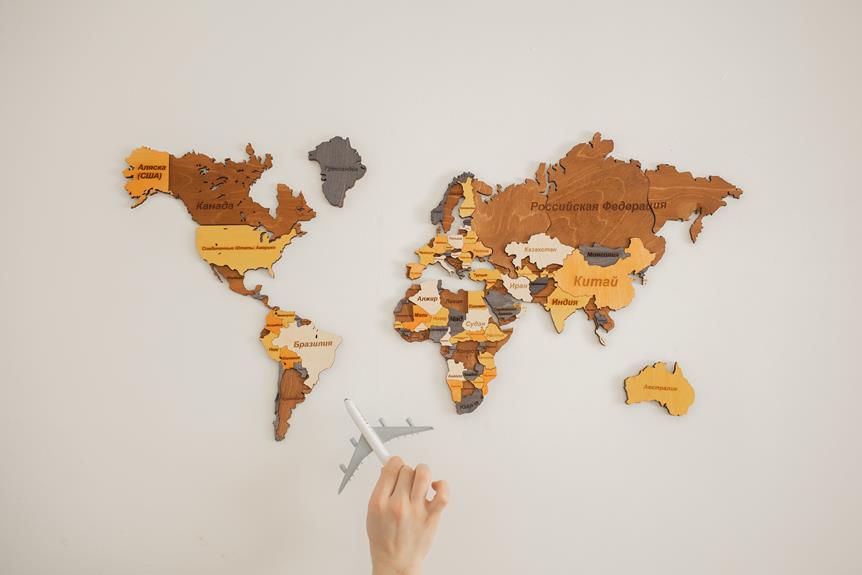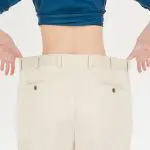Did you know that there are 10 specific parts to a pair of pants?
Understanding the names of these pant parts can give you a deeper appreciation for the intricacies of garment construction. From the waistband to the seat, each part serves a distinct purpose in creating a well-fitted and comfortable pair of pants.
Whether you are a fashion enthusiast, a tailor, or simply someone who appreciates attention to detail, knowing these pant parts will enhance your understanding of clothing design and construction.
So, let's delve into the world of pant parts and expand your mastery of this fundamental wardrobe staple.
Key Takeaways
- Understanding waistband styles helps in choosing comfortable pants.
- Different pocket styles serve different functions and add visual interest.
- The inseam measurement is crucial for finding the perfect fit.
- Rise determines how pants fit and feel, and can flatter body shape.
Waistband
Did you know that the waistband of pants is the strip of fabric encircling the upper edge of the garment? The design and construction of the waistband play a crucial role in the comfort and style of the pants.
Waistband comfort is essential for a pleasant wearing experience. A well-designed waistband should provide support without feeling constricting. It should sit comfortably against your body without digging in or causing discomfort, allowing you to move freely throughout the day.
When it comes to waistband styles, there are several options to consider. Some pants feature a standard waistband with a button and zipper closure, while others may have an elasticized waistband for added flexibility and ease of wear. Additionally, there are contoured waistbands that are shaped to fit the natural curves of the body, providing a flattering and comfortable fit.
Understanding different waistband styles can help you choose pants that not only look great but also feel comfortable to wear.
Belt Loops
The waistband of pants typically includes belt loops that allow you to secure a belt for added style and practicality. Belt loops aren't just functional; they're also a key styling element for your pants. When it comes to styling tips, consider the number of belt loops on your pants.
More belt loops provide better support for your belt, preventing it from slipping or twisting. Additionally, different belt loop sizes can accommodate various belt widths, so be sure to choose a belt that matches the size of your loops for a polished look.
For styling purposes, it's essential to understand that the spacing between belt loops can vary. Some pants have closer spacing, which can create a sleeker appearance when a belt is worn. On the other hand, wider spacing between loops can give a more casual and relaxed vibe.
When selecting a belt for your pants, ensure that the width corresponds to the size of the loops. This attention to detail will enhance your overall look and ensure that your belt fits seamlessly into your ensemble.
Pockets
When it comes to the functionality and style of pants, pockets are a crucial feature that adds both utility and visual interest to the garment. While belt loops provide support and style, pockets offer practical storage for everyday essentials and can also contribute to the overall aesthetic of the pants.
- Pocket Styles:
- Different pocket styles, such as patch pockets, slant pockets, and welt pockets, not only serve different functions but also create varying visual effects, adding depth and dimension to the pants.
- Functionality of Pockets:
- Pockets aren't only for storage but also for accessibility. They allow you to conveniently carry items like keys, phones, or wallets without the need for an extra bag, adding to the convenience and practicality of the garment.
- Aesthetic Contribution:
- The design and placement of pockets can significantly impact the overall look of the pants. Whether they're front, back, or side pockets, they can enhance the visual appeal and complement the style of the pants.
Understanding the different pocket styles and the functionality they offer can help you choose pants that not only look great but also cater to your practical needs.
Inseam
Have you ever wondered about the length of the inseam in your pants? The inseam is a crucial measurement when it comes to finding the perfect fit for your trousers. It is the distance from the crotch seam to the hem of the pants and plays a significant role in how the pants drape and fit on your legs. When determining the inseam, it's important to consider various measurement techniques and fit considerations to ensure the pants are tailored to your body.
Here's a table for a quick reference guide on inseam measurement techniques, fit considerations, fabric choices, and styling options:
| Measurement Techniques | Fit Considerations | Styling Options |
|---|---|---|
| Traditional method: Measure from crotch to desired pant length | Ensure the pants have the right amount of break at the bottom | Cuffing the pants can make them appear shorter |
| Tailor's assistance: Seek professional help for accurate measurements | Consider the rise of the pants for overall comfort | Opt for a tapered leg for a modern look |
| Online guides: Use online tutorials for self-measurement | Check the fit around the hips and thighs | Experiment with different fits like straight-leg or wide-leg |
When it comes to fabric choices, lighter materials like cotton or linen are great for a casual, summery vibe, while wool or heavier fabrics can be ideal for a more formal or winter look. Styling options include cuffing the pants for a trendy touch or opting for a classic straight-leg fit for a timeless appearance. Whether you're aiming for a tailored, professional look or a relaxed, casual style, understanding the inseam and its related aspects is key to achieving the perfect pant fit.
Outseam
Did you ever notice the line running down the side of your pants? That's the outseam, and it plays an important role in the construction of your trousers. Understanding the outseam and its differences from the inseam can help you appreciate the craftsmanship of your pants even more.
Outseam Construction
- Precision Stitching: The outseam is meticulously stitched to ensure a smooth and polished appearance, contributing to the overall aesthetic of your pants.
- Structural Integrity: It provides structural support to the pants, helping them maintain their shape and drape properly on your body.
- Style Element: In some cases, the outseam is deliberately highlighted as a design feature, adding a touch of sophistication to the garment.
Outseam vs Inseam Differences
The outseam runs along the outer leg of your pants, while the inseam runs along the inner leg. Understanding this contrast can deepen your appreciation for the thought and detail that goes into creating a well-constructed pair of trousers.
Cuff
As you look at the bottom of your pants, you'll notice the cuff, which serves as a finishing detail for the hem. Cuff styles can greatly impact the overall look of your pants, so it's important to understand the different options available. When it comes to cuff styles, there are a few popular choices to consider:
| Cuff Style | Description |
|---|---|
| Straight | A classic cuff style that provides a clean and timeless appearance. |
| Turn-up | Also known as a rolled cuff, this style offers a more casual and relaxed look. |
| French | This style features a shorter cuff and is often seen on tailored dress pants. |
| Notched | Characterized by a small triangular cutout on the outer edge of the cuff. |
When it comes to cuff alterations, it's essential to find a skilled tailor who can make precise adjustments. Cuff alterations may involve lengthening or shortening the cuff, changing the cuff style, or even removing the cuff altogether. Keep in mind that cuff alterations can significantly impact the overall appearance and fit of your pants, so it's crucial to communicate your preferences clearly to the tailor.
Rise
Hey there!
Ever wondered why some pants fit differently around the waist and hips?
The rise of a pant is the key factor that determines how they fit and feel on your body.
Understanding the impact of rise on the overall fit of your pants can help you find the perfect pair for your body type and style.
Pant Rise Explained
When choosing pants, it's essential to consider the rise, which determines where the waistband sits on your body. Understanding pant rise can significantly impact your comfort and overall look. Here's why the pant rise matters:
- Fashion Trends: Different rises come in and out of fashion. Understanding the current trends can help you stay stylish and up-to-date with your wardrobe choices.
- Body Shape Considerations: The right rise can flatter your body shape, accentuating your best features and providing a comfortable fit. It's crucial to know which rise works best for your body type to enhance your overall appearance.
- Confidence Boost: Wearing pants with the right rise can boost your confidence, making you feel comfortable and stylish in your clothing choices.
Impact on Fit
Regularly, you should consider the impact of pant rise on fit when choosing the right pair of pants for your body type.
The pant rise, which determines where the waistband sits on your body, greatly influences how the pants will fit and look on you.
A higher rise can provide more coverage and a better fit for those with longer torsos, while a lower rise can elongate the legs and is often preferred by individuals with shorter torsos.
Fabric selection plays a crucial role in the way the rise affects the fit. Stretchy fabrics may accommodate different body shapes, while stiffer fabrics may require specific tailoring techniques to ensure a comfortable fit.
Understanding the impact of pant rise on fit and considering fabric selection and tailoring techniques will help you find the perfect pair of pants for your body type.
Seat
When sitting, the seat of pants refers to the area that makes contact with the chair or surface. When it comes to the seat of your pants, comfort and design play crucial roles in ensuring an optimal fit and style. Here's what you need to know:
- Seat comfort: The comfort of the seat is essential for your overall satisfaction with the pants. A well-designed seat ensures that you can sit comfortably for extended periods without feeling any discomfort or tightness.
- Seat design: The design of the seat can greatly impact the overall look and feel of the pants. A properly designed seat not only enhances the aesthetics but also contributes to the functionality of the garment. From pocket placement to seam construction, every aspect of the seat design can influence the way the pants fit and feel.
Understanding the intricacies of seat comfort and design empowers you to make informed choices when selecting pants that not only look great but also offer superior comfort and fit.
Frequently Asked Questions
What Are the Different Types of Closures Used for Waistbands in Pants?
When fitting pants, it's essential to consider different types of closures for waistbands. Adjustable options like elastic or drawstrings provide comfort. The proper waistband fitting ensures a comfortable and flattering look for any body type.
How Are Belt Loops Typically Spaced on a Pair of Pants?
Belt loops on pants are typically spaced evenly around the waistband to ensure the belt sits properly. This essential detail in pant construction and tailoring techniques not only provides functionality but also follows fashion trends and styling tips.
Are There Any Special Types of Pockets That Are Commonly Found on Pants?
Sure, there are various types of cargo pockets, including bellows, slash, and patch pockets. Hidden pockets for pants can be found in the waistband, inside the front pockets, or even in the back pockets.
How Is the Inseam Measurement Typically Taken on a Pair of Pants?
When fitting pants, take the inseam measurement from the crotch to the hem. This determines the length of the pant leg. Alteration techniques can adjust the inseam for a perfect fit. Fabric selection impacts pant construction and fit.
What Are Some Common Variations in Cuff Styles for Pants?
When it comes to different cuff styles and hemming techniques for pants, there's a range of options to explore. From rolled cuffs to tailored hems, and customized waistbands to adjustable closures, the possibilities are endless.
- Comparing Nonwoven Geotextile Fabric for Driveways and Drains - July 11, 2025
- Nonwoven Polypropylene: Is It Washable and Reusable? - July 11, 2025
- All About Spunbond Nonwoven Fabric and Its Uses - July 11, 2025






